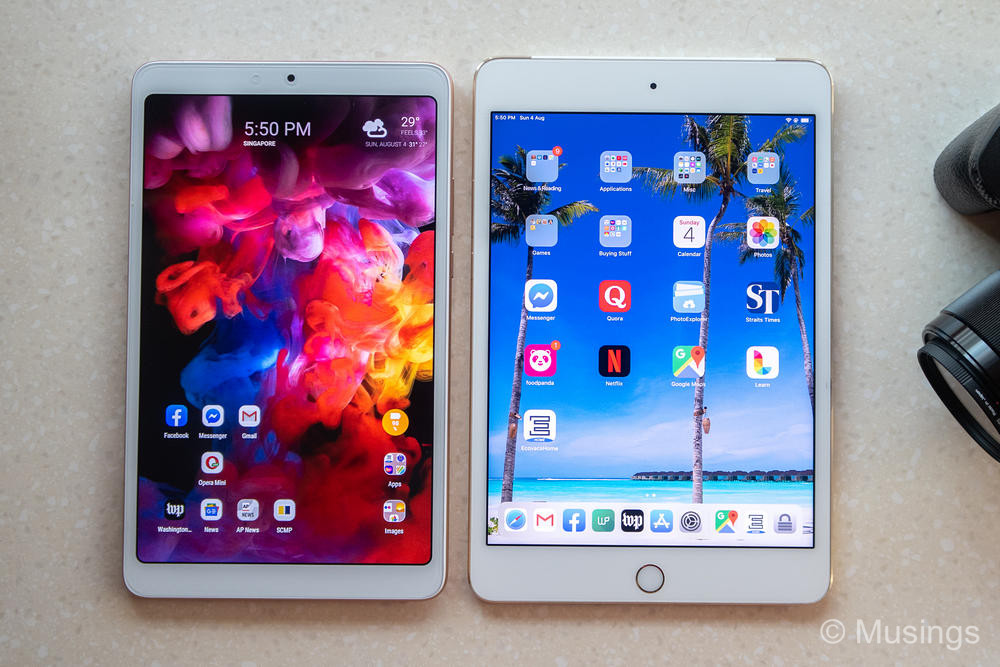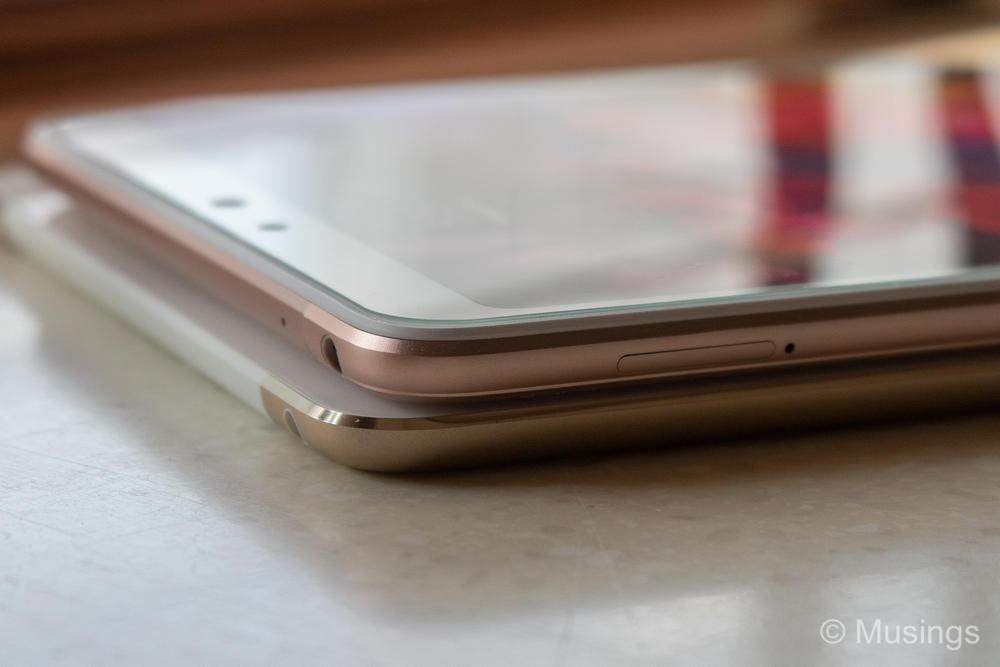My further on first impressions of the new Mi Pad 4! The tablet has still yet to complete its boot unlock – Mi requires a waiting time of a week or so after you request a device unlock – so the device has still been running on its stock Chinese ROM, albeit with Google Play already side-loaded from earlier.
I no longer have the Google Nexus 7 from more than six years back – it was sold away last year – but the Mi Pad 4 is about the same height, slightly wider but also thinner than that old tablet from 2013. Quite a marvel how fast technology has moved, as the Mi Pad 4 squeezes a 8.0” display into the same form factor where the Nexus had a 7.0” display. Size-wise and compared to the Apple iPad Mini 4, the Mi Pad 4 is much less wide and very slightly shorter and as a result of its thin bezels, offers a far better body to screen ratio of 77.1% compared to 70.6% as noted by GSMArena. These numbers aside, the taller screen helps a lot when browsing web pages in portrait mode. The slab however is also noticeably thicker – it’s 7.9mm compared to iPad’s 6.1mm – and also quite a bit heavier at 342.5g vs 304g. The Mi Pad 4 though is still light for a tablet, so no, your fingers are unlikely going to complain in short order from holding the tablet one-handed for a period of time.
The Mi Pad 4 comes with a pretty large battery for its size: a whopping 6,000mAh – compared to the 5,124mAh the iPad Mini 4 came with. Oranges and Apples comparison one would immediately counter since iOS tablets are supposed to be extremely power efficient, but the Xiaomi seems to have matched Apple in this case. I’m not equipped to do rigorous battery life testing, but one review site has reported that the Mi Pad 4 offers 914 minutes of H.264 video playback compared to the 660 minutes on the iPad Mini 4 – that’s almost 40% more, despite the just about 17% additional mAh. Nonetheless, the standby time on iPad remains longer. For my daily use so far, the Mi Pad 4 can easily get through an entire day of semi-heavy use of browsing at about 70-80% brightness levels, so battery life on this new tablet is all good for me.


Most users of the tablet have also remarked that the display on the Mi Pad 4 is somewhere between acceptable to good depending on reviewer, and I agree. It’s a decent enough display with good viewing angles. It’s also slightly less contrast-y compared to the iPad Mini 4’s, much less the True Tone display that the new iPads use. The maximum brightness is also lower, as is also visibility when in direct sunlight. Neither the iPad Mini 4 nor the Mi Pad 4’s displays offer the kind of deep blacks and punchy colours found on AMOLED panels, but for this price-point on the Mi Pad 4, one really shouldn’t be complaining too much.
The Mi Pad 4 also supports Face Unlock. Face recognition is rather iffy though: at times, logging in is instantaneous, and other times hesitant with the tablet asking if I could open my eyes a little wider LOL. It would had been nice if the tablet had a fingerprint sensor. And if not, a resized pattern lock that sits on the lower left corner so that I can unlock the tablet while holding it on the same hand.
Onto apps, and side-tracking a bit. Much has been said about the quality of apps on Google Play as compared to the iOS equivalents – whether it’s in how slick and polished the general quality of app is, or the malware that has seeped into a number of apps. One accepted counterpoint to that point is of course the sheer number of Android devices out there put out by every high tech mobile gadget manufacturer and their kitchen sinks, while Apple has a far smaller number of devices it needs to ensure its apps work on. In all honesty though, I’ve never found the quality of apps on Google Play to be especially debilitating for my use cases. I’ve always used my tablets for largely reading, writing and the occasional office productivity tasks and not to game, and I’ve largely stayed with the same staple of apps from device to device.
For instance, some of the apps I loaded up on the Mi Pad 4 were purchased 9 years ago when I bought my first Android gadget (the first Samsung Galaxy S in June 2010). Productivity apps as a rule do not tax hardware, and while newer or alternate versions of these productivity apps continue to appear on Google Play daily, the kind of functionality they offer doesn’t seem to change as much. Sure, new apps tend to run just that bit more fluidly and they’ll offer nicer UIs. But fundamentally, they still do the same thing as their almost decade-old predecessors. So, bottom line: iOS apps do look generally good, but so do their Android counterparts today. The Mi Pad 4 comes with a pretty good processor – the Snapdragon 660. It’s not in the same league as what you’d get on Android flagship phones right now, but the mid-range processor is perfectly OK for normal productivity. Apps load up quick, and swiping pages using browsers or switching between apps is fluid and brisk.
One of the best things of the Android over iOS devices remain how much you can customise the look and feel of its OS layer to suit how you want to use them. You primarily hold your 8.0” tablet on your left hand and want to use it as a single-handed device? Easy – just move the icons of your most-often used apps to the left (or right) side of the desktop, resize and fit them as you need. You want your home screen to show you everything you need at a glance – e.g. current battery drain, weather, clocks in two cities, network speed, and your day’s agenda? Easily done on Android tablets but next to impossible on the iPad, though the upcoming iOS 13 might somewhat alleviate this deficiency in its tablets.
Key to such desktop customisation in Android devices is the Home launcher you’re using. All Android devices come with manufacturer stock versions included as a component of their supplied OS. The current OS version on Xiaomi devices is MIUI 10, and it – like Oppo’s ColorOS – offers a range of customisation possibilities that surpasses the One UI that the current generation Samsung devices come on, and the MIUI launcher’s overall look takes cues from iOS. That said, I prefer third party launchers compared to stock versions, and over the years have mostly stuck to the same one in my Android gadgets – and it’s Nova Launcher. The paid version of the app is well worth the small expense, and I’ve been able to use the Launcher across my last half-dozen Android phones and tablets (excepting the Oppo Reno – more on that in a bit). Microsoft also has its own launcher, and the bland name aside – it’s called Microsoft Launcher LOL – allows you to setup your phone’s look and feel broadly like Nova’s, and you don’t have to pay a cent for the app either. My Oppo Reno currently uses the Microsoft Launcher – specifically because ColorOS does not work well with Nova Lancher e.g. WhatsApp notifications are buggy – but the Nova Launcher works just perfectly well on the Mi Pad 4. I can disable docks, notification and status bars and fully use each Home Screen for full-screen widgets, something that the Microsoft Launcher was struggling with when installed on top of MIUI.
One of the common criticisms against the Mi Pad 4 is also the amount of bloatware MIUI comes with, and some users just do not want any trace of the Chinese OS on their devices. There are custom ROMs of course which will strip the tablet off these manufacturer installed apps, but I honestly didn’t find the pre-installed apps too much of a bother. I was able to easily uninstall roughly half of them. And for the others, depending on the Home Launcher you use, I was able to able to hide them from normal view. Both Nova and Microsoft Launchers offer a nifty feature that lets you hide whichever apps that annoy you from the App Drawer, so that the only time you’ll normally otherwise see them will be in Settings.
Oddly enough too; there are a small number of apps that just wouldn’t work on the Mi Pad 4, and I suspect it’s because of how I’ve setup permissions after side-loading Google Play Framework and Services. So far, it’s the FoodPanda app – it keeps insisting that my current country isn’t supported even when it’s GPS assures that I’m in Singapore – and also Tripadvisor, which doesn’t get past the logo screen no matter how many times I’ve installed and re-tried launching the app. Thankfully, neither presents insurmountable challenges: I can easily access both sites through browsers.
Likewise, browser links to Google Play apps are still pointing to Mi Store rather than Google Play Store. Not an insurmountable challenge to overcome, since one just needs to go directly Google Play to look for the app, but it’s also still an annoyance.
In all, this is a fun and lovely gadget, made especially palatable with its very low asking price that’s less than half of an equivalent new iPad Mini 5. The battery life is more than sufficient, display brightness and viewing angles are acceptable even if colors aren’t as eye-popping as an AMOLED display, and performance is great. There are just a few Google Play and app oddities which I suspect is because of how Google Play was side-loaded into the tablet. They aren’t particularly crippling as I’ve got workarounds.
Nonetheless, once the mandatory week long Mi Pad 4 unlock cooling period is over, I’ll probably give one the custom ROMs a go, so there might be a follow-up post on this tablet in the next week or so. More to come soon then, probably. :)
Recent comments